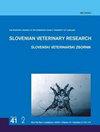COMPARISON BETWEEN RAPID AND SLOW CRYOPRESERVATION PROTOCOLS FOR RAM SEMEN
IF 0.6
4区 农林科学
Q4 VETERINARY SCIENCES
引用次数: 1
Abstract
Information regarding adequate freezing protocols of ram semen considering freezing distance and time during cryopreservation has not been adequately reported. Therefore, this study aimed to compare two freezing protocols for Najdi ram's semen. In the rapid freezing protocol, the straws were frozen at 5 cm over the surface of liquid nitrogen for 15 minutes. While in the slow freezing protocol, the straws were frozen at 8 cm over the surface of liquid nitrogen for 20 minutes. The semen was collected from five rams and extended with tris egg yolk glycerol cryodiluent. The extended semen was chilled slowly to 50C within two hours and equilibrated for two hours before being frozen on the liquid nitrogen vapor and cryopreserved at -1960C. There was no significant (P >0.005) effect of the freezing protocol on the sperm’s total motility, plasma membrane integrity, DNA integrity, and abnormalities. However, the vitality, fast progressive motility, straight-line velocity, average pathway velocity, linearity, and wobble were significantly higher in rapid freezing than in slow freezing protocol. In conclusion, cryopreservation of ram semen using rapid freezing (5 cm for 15 mins) protocol was better than slow freezing (8 cm for 20 mins) protocol regarding post-thawing semen quality. Key words: freezing protocol; cryopreservation; egg yolk; ram; semen公羊精液快速与慢速冷冻保存方法的比较
考虑到冷冻保存期间的冷冻距离和时间,关于公羊精液适当冷冻方案的信息尚未充分报道。因此,本研究旨在比较Najdi ram精液的两种冷冻方案。在快速冷冻方案中,将吸管在液氮表面上方5cm处冷冻15分钟。而在慢速冷冻方案中,将吸管在液氮表面上方8cm处冷冻20分钟。从五只公羊身上采集精液,并用三蛋黄甘油冷冻稀释剂稀释。延长的精液在两小时内缓慢冷却至50摄氏度,并平衡两小时,然后在液氮蒸汽上冷冻并在-1960摄氏度下冷冻保存。冷冻方案对精子的总运动能力、质膜完整性、DNA完整性和异常没有显著影响(P>0.05)。然而,快速冷冻方案的活力、快速渐进运动、直线速度、平均路径速度、线性和摆动显著高于慢速冷冻方案。总之,在解冻后精液质量方面,采用快速冷冻(5cm,15分钟)方案冷冻公羊精液优于慢速冷冻(8cm,20分钟)方案。关键词:冷冻协议;冷冻保存;蛋黄;猛撞精液
本文章由计算机程序翻译,如有差异,请以英文原文为准。
求助全文
约1分钟内获得全文
求助全文
来源期刊

Slovenian Veterinary Research
VETERINARY SCIENCES-
CiteScore
0.60
自引率
0.00%
发文量
12
审稿时长
>12 weeks
期刊介绍:
SLOVENIAN VETERINARY RESEARCH (ISSN 1580-4003) publishes original articles, which report the results of original research in most areas of biomedicine. The journal also publishes review articles dealing with rapidly developing areas of biomedicine or which update understanding of classical fields of biomedicine, as well as case reports, shorter scientific contributions, letters to the editor, etc.; which have not been published or are under consideration for publication elsewhere. Only papers written in English can be considered.
 求助内容:
求助内容: 应助结果提醒方式:
应助结果提醒方式:


